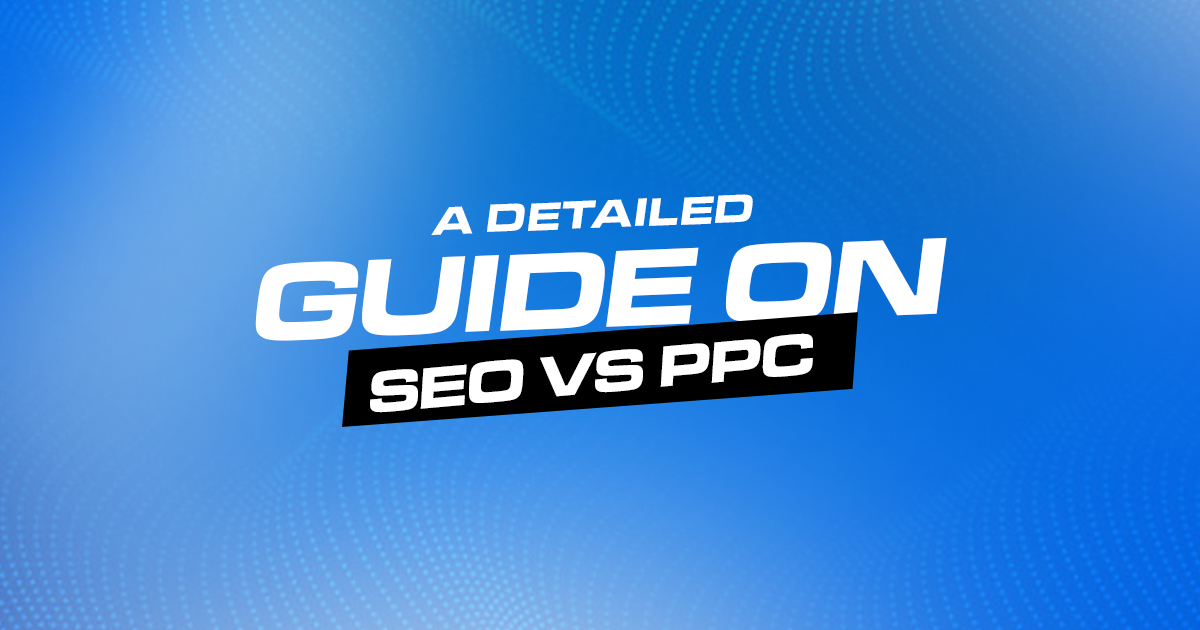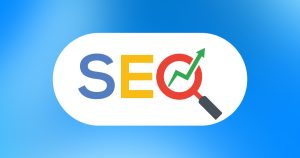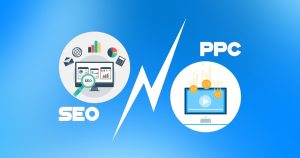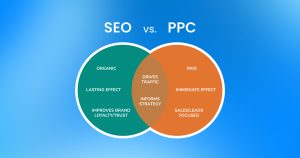SEO VS. PPC : A Detailed Guide on Everything

Table of Contents
Have Any Idea or Project in Your Mind? Call Us or Schedule an Appointment!
PPC and SEO are the most effective marketing strategies for increasing a website’s visibility, driving traffic, and generating more revenue. However, the basics of PPC and SEO differ.
This guide provides detailed information about SEO and PPC, including their best practices, applications, advantages, and disadvantages. It also includes some strategies which involve the simultaneous use of SEO and PPC for better results and maximum benefits.
Understanding SEO & PPC
SEO is the acronym for Search Engine Optimzation. This technique is used to help search engines better comprehend your website’s content and deliver relevant, valuable results to the users based on their queries. The ultimate goal of SEO is to rank your website on the first page of SERPs (Search Engine Results Pages) for the most relevant keywords that help drive qualified traffic to your website by targeting the right audience.
PPC stands for pay-per-click and is a digital advertising model in which the advertiser has a pay a fee every time their ad is clicked by anyone on the internet. It means you have to pay for targeted visits to your online application, landing page, or website. A successful PPC campaign makes the fee worth it because you get more than what you are paying for ads.
SEO involves no charges for website clicks, and management rates vary. The SEO websites appear below the paid search results, and you start getting your desired results in 3 to 6 months as the focus of SEO lies on organic visibility. However, PPC rates are charged per ad click and management rates vary. PPC ads appear above the organic results in search results, and you get results soon after launching, as PPC focuses on paid visibility.
Both these strategies involve using different tactics and tools for delivering short-term and long-term results. The decision of choosing PPC or SEO is based on your goals, such as PPC helps you in getting instant visibility for generating sales quickly, while SEO assists in growing website traffic in the long run.
SEO (Search Engine Optimization)
SEO is the acronym for Search Engine Optimization. This process involves the optimization of a website for improving its visibility in organic SERPs (Search Engine Results Pages).

Essential Components of SEO
Keyword Research
Keyword research is done to comprehend the phrases and words frequently used by your targeted audience when they search for something on search engines. Different keyword research tools can be used for this purpose.
On-Page SEO
On-page SEO involves the creation of content that your targeted audience wants to see and the addition of internal links to your content. Before creating such content, you need to know the search intent for aligning your content with the reasons why the audience makes a particular query. On-page SEO also involves the strategic placement of keywords, such as in the title, compelling title creation, utilizing descriptive and short URLs, and image optimization. This method proves to be helpful for crawling and indexing all pages by the search engine leads to enhanced website ranking and more organic traffic.
Off-Page SEO
Off-page SEO involves practices outside your website to show the search engine that your website pages are well-deserving of ranking. You can build high-quality backlinks, as they are among Google’s top ranking factors, which help in getting votes from other websites. Moreover, you can also promote social engagement by getting brand mentions, citations, and reviews to drive your website’s authority and trustworthiness.
Technical SEO
Technical SEO helps ensure the finding, crawling, and indexing of your content by the search engine. It helps in improving your ranking on the search engine by letting it know that your website fulfils all technical requirements, such as mobile friendly design, etc.
Content SEO
Optimizing your content means creating quality content that helps improve your website’s ranking in search results. For content SEO, you have to focus on keyword strategy for higher ranking. You need to naturally add keywords throughout in your content and headings, ensuring proper structuring of the content with added H-tags.
Advantages of SEO
The following are some of the advantages of using SEO:
- You do not have to pay if someone clicks on your listing that appears in organic search results.
- You can reach potential users based on the buying funnel without any risk of ad blockers that hide your website.
- You can get consistent traffic to your website as long as you are ranking high on Google with your targeted keywords.
- Potential traffic is attracted to your website, which, as a result of SEO, contributes to generating more leads and sales.
- It is a long-term investment because it brings better results over time, guaranteeing effective ROI (Return on Investment).
- Your website starts appearing throughout the buying funnel, helping you depict your authenticity and build trust with users.
- You do not need to target your audience often and make budget adjustments, requiring less maintenance for your considerable results.
Disadvantages of SEO
Some of the potential disadvantages of SEO include:
- You need to manually calculate SEO’s return on investment, which is difficult.
- You do not get instant results overnight; you start getting ROI after almost 3 to 6 months.
- You must publish unique and authoritative content, requiring you to invest time and resources for efficient results.
- The competition is increasing in the market, making it difficult to rank against high-volume keywords, which can affect your ROI.
- To guarantee ultimate success, you need to be highly skilled in different areas of SEO, such as content writing and web development.
- Ranking factors, including resolving page speed problems, can change at any time due to search engine algorithms, requiring you to make efforts by opting for new strategies.
PPC (Pay-Per-Click)
PPC stands for Pay-Per-Click. It is an advertising technique for promoting different brands, products, or services on ad networks using a CPC (Cost-Per-Click) bidding model. For PPC marketing, the advertiser pays a fee every time someone clicks their ads. Search ads and social media ads are run under PPC.

Essential Components of PPC
Keyword Research
To target your audience with PPC advertising, you need to conduct keyword research. You can find the relevant keywords by exploring the search patterns of your targeted audience and creating content that grabs their attention and helps to achieve the desired results.
Bid Setting
Bid setting is the process of deciding the amount of money you are willing to pay Google for an ad click. You need to determine this amount strategically because if competitors outbid you, Google will not show your ad frequently, which leads to fewer clicks and fewer sales.
Ad Creation
During ad creation, you need to decide about the message you want to deliver and your targeted audience. Google gives your launched ads a Quality Score, which indicates the relevance and usefulness of your ad. If your ad has a higher Quality Score, it means more individuals have seen your ads, and you will have to pay less for clicks.
Audience Targeting
This is the step in which you have to target the audience to which you want to show your ad. You can choose different targeting strategies based on who the audience is, their interests, their location, etc.
Advantages of PPC
PPC offers the following advantages
- You can instantly start a campaign by heading over to any ad platform.
- You get fast ROI immediately after your ads go live, driving revenue for your business.
- You get quick feedback, allowing you to monitor the results and set up a new campaign accordingly.
- ROI can be easily measured. Google Ads helps track return on investment as a result of PPC.
- PPC enables you to reach users throughout the buying funnel, requiring you to invest more as you get closer to purchase.
- You can reach your target market using advanced targeting options, such as demographics, interests, locations, etc.
Disadvantages of PPC
PPC also has some of the disadvantages, such as:
- You have to invest continuously to run ads and get sales as a result.
- The effectiveness of your campaigns lessens as they run for longer durations and are often visible to people.
- PPC requires more maintenance, such as bidding, making ad copies, revising keywords, etc for minimizing ad fatigue.
- The effectiveness of PPC is impacted by ad blockers, ad fatigue, and fraudulent clicks, which result in a quick drain on your budget.
Strategies to Use SEO & PPC Simultaneously
Implementing PPC and SEO together is one of the best marketing strategies for attracting more user traffic, generating leads, and having more sales. The following are some of the tactics you can use to combine SEO and PPC strategies and generate your desired results:

1. SEO Content & Paid Ads
You can run paid ads for promoting organic content and enhancing its visibility in search results. To get the most out of this strategy, you need to create content based on your targeted audience’s interest. Moreover, you should ensure you are choosing the topics that are most relevant to your specific niche for good ad performance.
2. Organic CTR & PPC Data
CTR (Click-Through Rate) is one of the most influential metrics in SEO. You can use the data gained through top, middle, or bottom-of-funnel terms to formulate the title tags and H1 headings of your relevant organic content.
3. Organic Traffic & Retargeting
PPC and SEO can be efficiently combined with retargeting. The retargeting strategy helps you in delivering ads to users who visit specific sections of your website. While retargeting, you can add extra filters, such as certain locations, particular page flows, etc.
4. SEO Content Optimization & CTAs
Paid ads are one of the most effective ways to drive conversions. You can achieve your conversion goals by adding relevant CTAs (call-to-actions) and enhancing the visibility of your SEO content with the help of paid ads.
5. Organic Content & Competitor Ads’ Targeting
The advertising platforms used by your competitors provide information regarding their goals, such as driving leads, sales, or traffic. You can also analyze the competitors’ advertising strategies to create organic content that helps capture traffic at cost-effective rates.
Conclusion
You can enhance the visibility of your website while gaining a competitive edge by implementing best SEO practices. On the other hand, you can reach your targeted audience directly and boost your brand’s visibility with PPC. Moreover, you can also combine both strategies to get the desired results and enjoy maximum benefits. However, the final decision to opt for a particular strategy depends on your preferences, business type, targets and objectives, budget, business requirements, etc.

